
Blandfordia, commonly known as Christmas bells, is a genus of four species of flowering plants native to eastern Australia. Christmas bells are tufted, perennial herbs with narrow, linear leaves and up to twenty large, drooping, cylindrical or bell-shaped flowers.
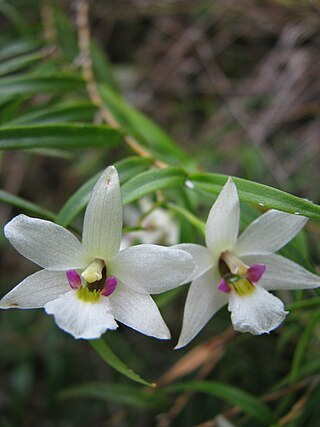
Dendrobium cunninghamii, commonly known as winika, pekapeka, Christmas orchid, bamboo orchid or ladies slipper orchid, is a species of epiphytic orchids that is endemic to New Zealand. It is commonly found growing in rainforest in the North, South, Stewart and Chatham Islands and normally flowers in summer and early autumn.

Blandfordia punicea, commonly known as Tasmanian Christmas bell, is a species of flowering plant that is endemic to western Tasmania. It is a tufted perennial herb with linear leaves and drooping red, bell-shaped flowers that are yellow on the inside.
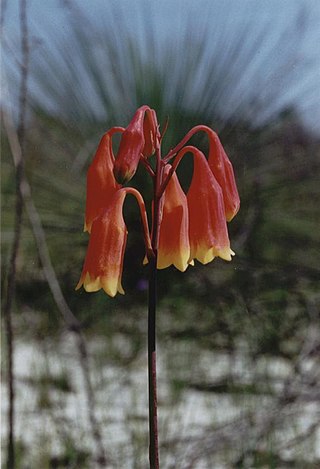
Blandfordia grandiflora, commonly known as Christmas bells, is a flowering plant endemic to eastern Australia. It is a tufted perennial herb with narrow, channelled, linear leaves and between two and twenty large, drooping, bell-shaped flowers. The flowers are red with yellow tips, or sometimes entirely yellow. It is one of four species of Blandfordia known as Christmas bells, this one growing on the coast and nearby ranges between Sydney in New South Wales and Fraser Island in Queensland.

Pennantia cunninghamii, known as brown beech, is a species of flowering plant in the family Pennantiaceae and is endemic to eastern Australia. It is a tree with a fluted trunk, elliptic or oblong leaves and white, either bisexual or male flowers.

Dendrobium wassellii, commonly known as the furrowed pencil orchid, is a species of orchid endemic to a small area on Cape York Peninsula. It is an epiphytic or lithophytic orchid with branched stems, cylindrical, furrowed leaves and flowering stems with up to sixty crowded white flowers with a yellow labellum.

Blandfordia nobilis, commonly known as Christmas bells or gadigalbudyari in Cadigal language, is a flowering plant endemic to New South Wales, Australia. It is a tufted, perennial herbs with narrow, linear leaves and between three and twenty large, drooping, cylindrical to bell-shaped flowers. The flowers are brownish red with yellow tips. It is one of four species of Blandfordia known as Christmas bells, this one growing on the coast and ranges south of Sydney.

Pterostylis gibbosa, commonly known as the Illawarra rustyhood, or Illawarra greenhood, is a plant in the orchid family Orchidaceae and is endemic to New South Wales. It has a rosette of leaves at its base and up to nine bright green flowers with translucent "windows", relatively wide lateral sepals with short-pointed tips and a dark, fleshy, insect-like labellum.

Dendrobium pugioniforme, commonly known as the dagger orchid is a species of orchid endemic to eastern Australia. It is an epiphytic or lithophytic orchid with pendulous, wiry stems, fleshy, sharply pointed leaves and flowering stems with one or two greenish or yellowish flowers with a white labellum. It grows on trees and rocks, mostly in humid forest.
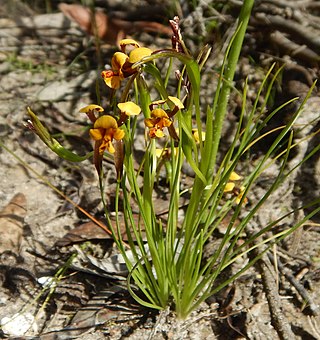
Diuris palustris, commonly known as the swamp doubletail or swamp diuris is a species of orchid which is endemic to south-eastern Australia. It has a tuft of between eight and ten twisted leaves and up to four yellow flowers with brown spots and blotches marks and blotches.
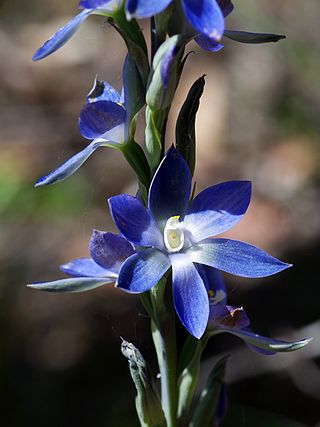
Thelymitra aristata, commonly called the great sun orchid, is a species of orchid that is endemic to south-eastern Australia. It has a single large, thick leaf and bracts and up to forty crowded blue or purplish flowers with darker veins.
Thelymitra albiflora, commonly called the white sun orchid, is a species of orchid that is endemic to South Australia. It has a single erect, narrow, fleshy leaf and up to ten relatively small white flowers with white toothbrush-like tufts on top of the anther.
Thelymitra angustifolia, commonly known as the long-leaved sun orchid is a species of orchid that is endemic to eastern Australia. It has a single erect, thin, channelled leaf and up to ten purplish blue flowers with white tufts on top of the anther. The flowers are self-pollinating.
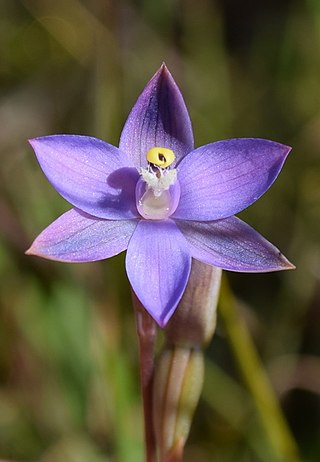
Thelymitra arenaria, commonly called the forest sun orchid, is a species of orchid that is endemic to south-eastern Australia. It has a single long, narrow leaf and up to sixteen purplish self-pollinating flowers which only open on hot days.

Thelymitra graminea, commonly called the shy sun orchid, is a species of orchid in the family Orchidaceae and is endemic to the south-west of Western Australia. It has a single leathery, channelled leaf and up to ten relatively small blue, self-pollinating flowers with white, toothbrush-like tufts on the top of the anther.
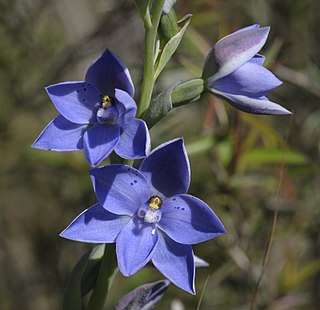
Thelymitra juncifolia, known as the large-spotted sun orchid, is a species of orchid that is endemic to south-eastern Australia and to New Zealand. It has a single thin, dark green leaf and up to five blue flowers with relatively large, dark blue spots on the dorsal sepal and petals. It is similar to T. ixioides but has fewer, smaller flowers with larger dark blue spots.
Thelymitra polychroma, commonly called the rainbow sun orchid, is a species of orchid that is endemic to Tasmania. It has a single narrow, fleshy leaf and up to four blue and mauve flowers with darker veins. It grows in windswept heath and swampy areas and the flowers are self-pollinated.
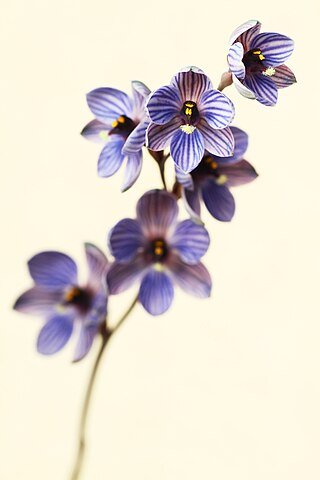
Thelymitra campanulata, commonly called the bell sun orchid or shirt orchid, is a species of orchid in the family Orchidaceae and is endemic to the south-west of Western Australia. It is a common species with a single narrow leaf and up to fifteen distinctly cup-shaped, prominently striped blue or mauve flowers with crowded, finger-like glands on top of the anther.
Thelymitra paludosa, commonly known as the plain sun orchid, is a species of orchid that is endemic to Western Australia. It has a single erect, channelled, dark green leaf and up to ten or more blue to violet flowers. It grows in higher rainfall areas near the south coast.
Thelymitra orientalis is a rare species of orchid in the family Orchidaceae and is endemic to southern continental Australia. It has a single thread-like, cylindrical leaf and a single deep blue, streaked flower. It is similar to T. mucida but is distinguished from that species by its filiform leaf and smaller flower.















